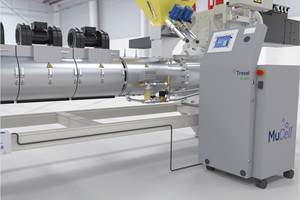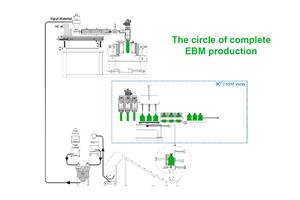New Report Details Aging of Manufacturing Workforce
Study from Manufacturing Institute also reveals best practices by companies that are meeting the challenge head on.
I had a wide variety of topics from which to choose as I sat down to write this column: the “greening” of K 2019 (coverage beginning on p. 36); the new boss at the Plastics Industry Association (PLASTICS), on p. 8; the decision of Coke and Pepsi to withdraw their membership from PLASTICS; the upcoming Manufacturing Day; and a few other things. Since some of those items are covered elsewhere is this issue, I decided to tackle another critical and timely subject: Workforce Development.
A piece of research hit my email box recently from the National Association of Manufacturers. Titled Aging of the Manufacturing Workforce: Challenges and Best Practices, the study concluded that attracting and retaining a quality workforce is one of the top challenges facing the manufacturing industry. As of 2017, the survey noted, nearly one-quarter of the manufacturing workforce is age 55 or older. Kind of scary. The Institute’s Center for Manufacturing Research collaborated with Keybridge Research for this study, which was funded by a grant from the Alfred P. Sloan Foundation.
The good news is that manufacturers have responded to the challenge in a variety of ways, including boosting recruitment efforts, adopting new technologies and taking steps to retain and maximize the productivity of their older workers (see p. 16 for an article on how one injection molder is dealing with the problem).
Key findings of the report include:
• Most manufacturing firms are both aware of and concerned about the aging of the manufacturing workforce. Almost all (97%) survey respondents report being aware of the issue, and the vast majority (78%) indicate that they are very concerned or somewhat concerned about this change.
• Manufacturing firms are particularly concerned about brain drain (loss of institutional and technical knowledge): 97% of firms express at least some concern about brain drain and almost half of firms indicate that they are “very concerned” about the issue. Survey results also show that many firms are concerned about a shortage of labor, declining productivity, and rising costs.
• Firms across the manufacturing sector are taking steps to mitigate the impact of the aging workforce on their ´óĎó´«Ă˝. Almost 90% of companies surveyed reported capitalizing on the talents and experiences of their older workers, and of these, 46% report benefiting from older workers “to a great extent.”
• Results from the survey and information collected during interviews with manufacturing firms show that those who have successfully dealt with the aging of their workforce target four main objectives, each of which can be achieved through a suite of underlying best practices.
Those four main objectives are:
1. Early Awareness
• Create open communication channels.
• Bring up retirement with employees as retirement age nears.
• Ensure that employees feel valued and secure.
2. Knowledge Transfer
• Establish and strengthen mentorship and apprenticeship programs.
• Collect and archive older workers' knowledge using centralized electronic records.
• Hire older workers with needed knowledge.
3. Retention and Productivity Maximization
• Make ergonomic adjustments and use robotics.
• Allow workers to transfer to another position internally.
• Adapt to workers' needs with flexible hours or phased retirement.
• Encourage workers to return part-time or through project contracting.
4. Boost Recruitment
• Incorporate older workers into recruitment efforts.
• Use referrals from older workers.
You can go themanufacturinginstitute.org and download the entire report. Click on Research on the top navigation bar, then select The Aging of the Manufacturing Workforce from the dropdown menu.
Related Content
Foam-Core Multilayer Blow Molding: How It’s Done
Learn here how to take advantage of new lightweighting and recycle utilization opportunities in consumer packaging, thanks to a collaboration of leaders in microcellular foaming and multilayer head design.
Read MoreBlow Molder with a Mission: CKS Packaging Shares Gains Of Its Phenomenal Growth
From three machines in 1986 to 27 plants nationwide today, this family-owned processor has prospered through unwavering customer service, committed employees and dedicated service to its community.
Read MoreHow to Extrusion Blow Mold PHA/PLA Blends
You need to pay attention to the inherent characteristics of biopolymers PHA/PLA materials when setting process parameters to realize better and more consistent outcomes.
Read MoreGet Color Changes Right In Extrusion Blow Molding
Follow these best practices to minimize loss of time, material and labor during color changes in molding containers from bottles to jerrycans. The authors explore what this means for each step of the process, from raw-material infeed to handling and reprocessing tails and trim.
Read MoreRead Next
Making the Circular Economy a Reality
Driven by brand owner demands and new worldwide legislation, the entire supply chain is working toward the shift to circularity, with some evidence the circular economy has already begun.
Read MoreSee Recyclers Close the Loop on Trade Show Production Scrap at NPE2024
A collaboration between show organizer PLASTICS, recycler CPR and size reduction experts WEIMA and Conair recovered and recycled all production scrap at NPE2024.
Read MoreBeyond Prototypes: 8 Ways the Plastics Industry Is Using 3D Printing
Plastics processors are finding applications for 3D printing around the plant and across the supply chain. Here are 8 examples to look for at NPE2024.
Read More












